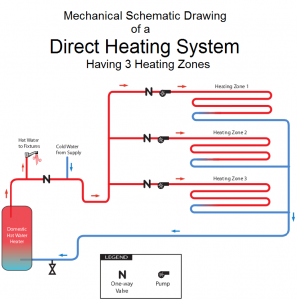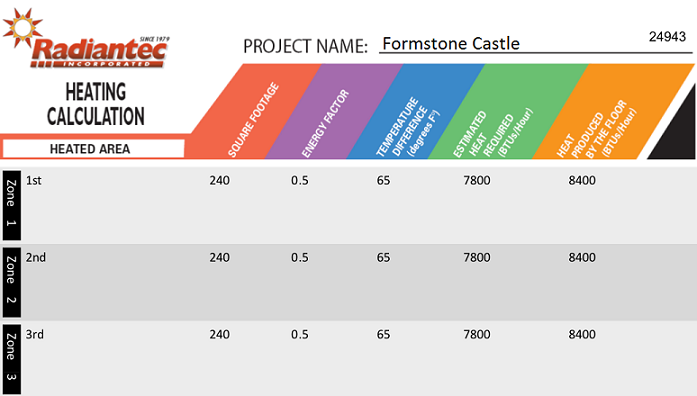Tags
Arduino, Furnace, Heating, Noritz, PEX, Radiant Floor, Radiantec, Water Heater
This has been an expensive week, but in a good way. We’ve ordered and received our radiant floor heating system. This is something we’ve been excited about since we first looked at the house. The house had a set of problems consisting of the following:
- Drop Ceilings – Ugly and had to go.
- Galvanized Piping – Old and prone to corrosion
- Water Heater – 20 years old and dead.
- Furnace – 50 years old and dead.
- Ducting – An utter mess. One of our chimney’s was used to hold both an exhaust pipe and serve as a heat duct.
We feel the Open Direct System by Radiantec was the best solution for this particular set of problems.
The Open Direct System uses the same domestic hot water heater that makes hot water for bathing and laundry to provide space heating, too. Everything in the system is made of materials that are fit to drink from, and a plumbing detail prevents stagnation of the water in heat tubes during the summer when space heating is not required. For details of this system, see Open Direct System or see page 23 of the Installation Manual. By reason of its efficiency, cost, and simplicity, this is our preferred system.
While we have the ceilings open, we can install the PEX tubing and insulation under the floors. We can also replace our galvanized piping in the basement as we reroute everything for the new system. By removing the old water heater and furnace with a single small wall mounted heater, we clear tons of floor space. We will not need ducting nor a chimney either. Heat is delivered in runs of 5/8″ PEX tubing and exhaust can vent through the wall via PVC pipe. With all this new found room in the basement I might have room for my secret laboratory!
I recommend reading through the Radiantec website for more info. It has a ton of articles about how this system works, potability, stagnation prevention, code compliance, and cost.
Part of going with Radiantec was to get them to spec out what we would need for our particular house. With under 1000 sq ft of heated space, heat requirements were low enough to substitute a cheaper Noritz [NV98-CV-NG] tankless condensing gas water heater rather than the more expensive Polaris and a MUCH more expensive boiler. This not only saves us money, but saves us floor space in our already tiny house. At 92% efficiency, I hope it will also keep our heating and hot water costs low. If not, we should be able to add solar water heating down the road.
While we went with their whole system for heating, we opted out of the thermostats supplied by Radiantec (for now) while I explore using an Arduino micro controller to control our heating and eventual air-conditioning systems. This is really nerdy stuff, but I’ve been waiting for a system control project to come up where I could play with it. I’ve ordered an Arduino Uno, Ethernet Shield, 10x DS18B20 temperature sensors, and an 8 channel solid state relay board (2A @ 120V / channel). The plan is to build a system that we can access by apps on our phones, or via a website that can also datalog our energy usage. If this doesn’t work, I eat the cost and we buy the Radiantec controls. I’m sure there is something fun I can do with an Arduino if this doesn’t work.
We’re so excited to start installing this stuff over the next few weeks. Really looking forward to warm toasty bare feet this winter too.



Pingback: » Electric Boogaloo Formstone Castle
Pingback: » Floors… Save the floors! Formstone Castle
How is the radiant floor working? I was thinking about a similar system. The simplicity of the system got my attention. Have you had any problems?
So far it has been great. We still haven’t gotten a thermostat though so our bills are a little higher than they could be. We usually just run it continuously and that works fine. If its starting to get too warm, we turn it off with a switch in the basement. This much water can hold heat for a while so even having it off for a night it still puts off heat for hours. Maybe this winter I’ll either build us a sweet control system or break down and get a Nest. One thing we were not told about staple up systems like ours is that creaking we get when the temperature changes. Little taps all over the place as the pipes expand and contract against the metal plates. Sort of sounds like rain though so it can be relaxing. Confuses that cat though.